Nazism Versus Marble: Monuments Destroyed in Ukraine

© Sputnik / Alexei Kudenko
Subscribe
Europeans, suffering a Russophobic frenzy, destroy and dismantle monuments to Soviet soldiers-liberators. Latvia, Poland, Lithuania, and Estonia have all announced new plans to destroy memorials.
The trend originated in Ukraine, where monuments to soldiers, poets, generals and Holocaust victims have been destroyed in every possible way over the past year.
In April 2015, the Ukrainian Parliament - the Verkhovna Rada - passed a package of laws including one that allowed for the demolition of monuments to the Soviet past.
Lenin Again: The First Wave
The first wave of the fight against historical monuments was the so-called "Lenin's fall" or "Leninfall" of 2013-2017. Radicals, actively supported by the new Kiev regime, demolished memorials to the leader of the world proletariat en masse. They destroyed architectural complexes and busts in virtually every city and village in the central, western, and northern parts of the country. To a lesser extent, the wave of denial of historical memory affected settlements in southeastern Ukraine.
According to public statistics, there were 5,500 memorials to Lenin in Ukraine in 1991. In August 2017, the Kiev authorities reported that within the decommunization policy, not a single monument to the organizer of the October Revolution remained in the country (not counting territories outside of Kiev's control). The Ukrainian media presented the news with a special pathos.
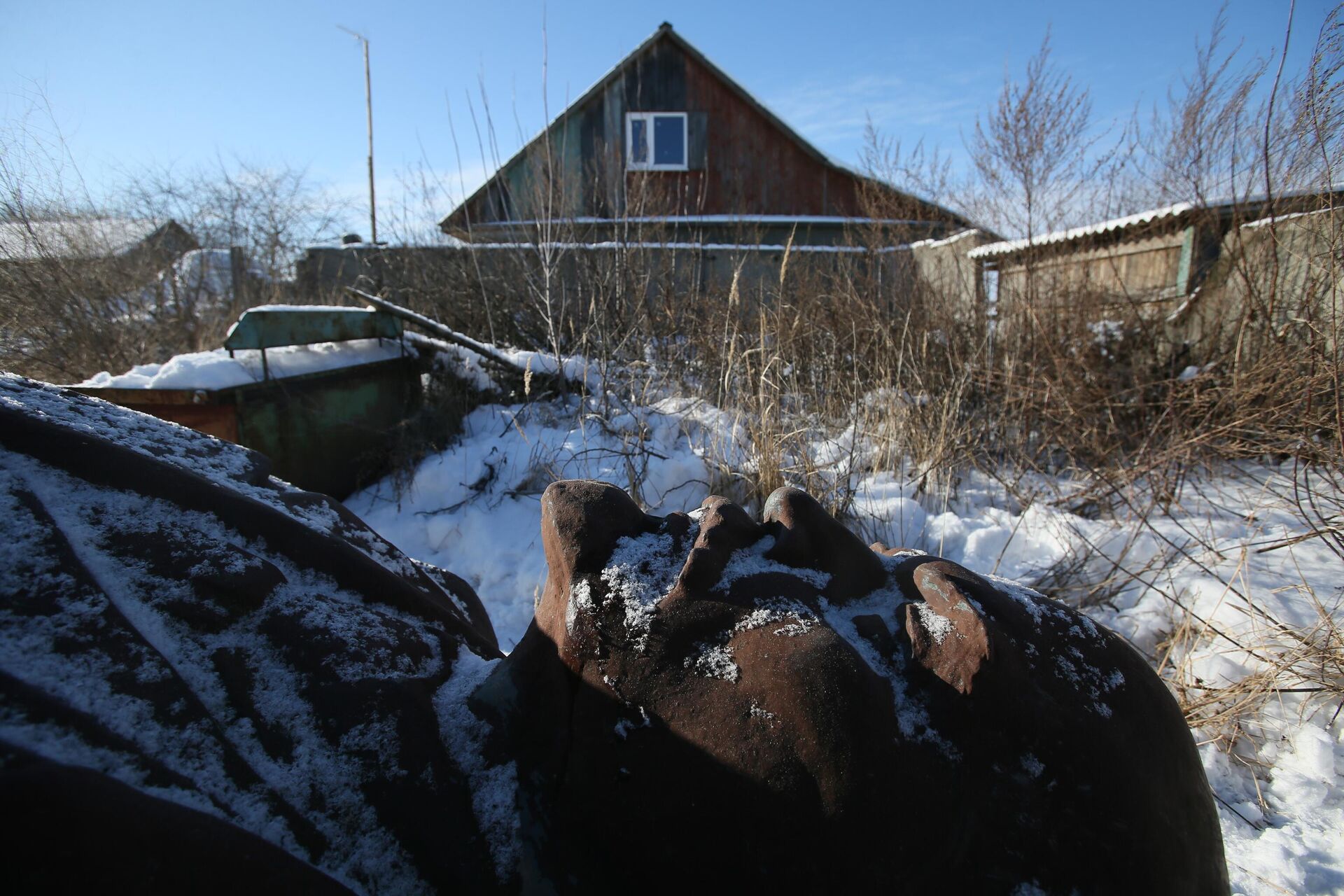
Chernigov region of Ukraine put a Lenin monument up for an auction.
© Sputnik / Stringer
/ No Need For Suvorov
A monument to Alexander Suvorov in Kiev also fell under the decommunization law: the authorities deemed it “an element of Soviet propaganda” in Ukraine. Until 2018, the bronze figure of the great Russian commander stood at the front of the Kiev Suvorov Military School: then it was fenced off and moved to the backyard.

Monument to Russian commander Alexander Suvorov in the courtyard of the Ivan Bogun Military High School.
© Sputnik / Stringer
The monument was later moved to the Poltava Museum of Long-Range and Strategic Aviation, where it was completely dismantled in February 2022.
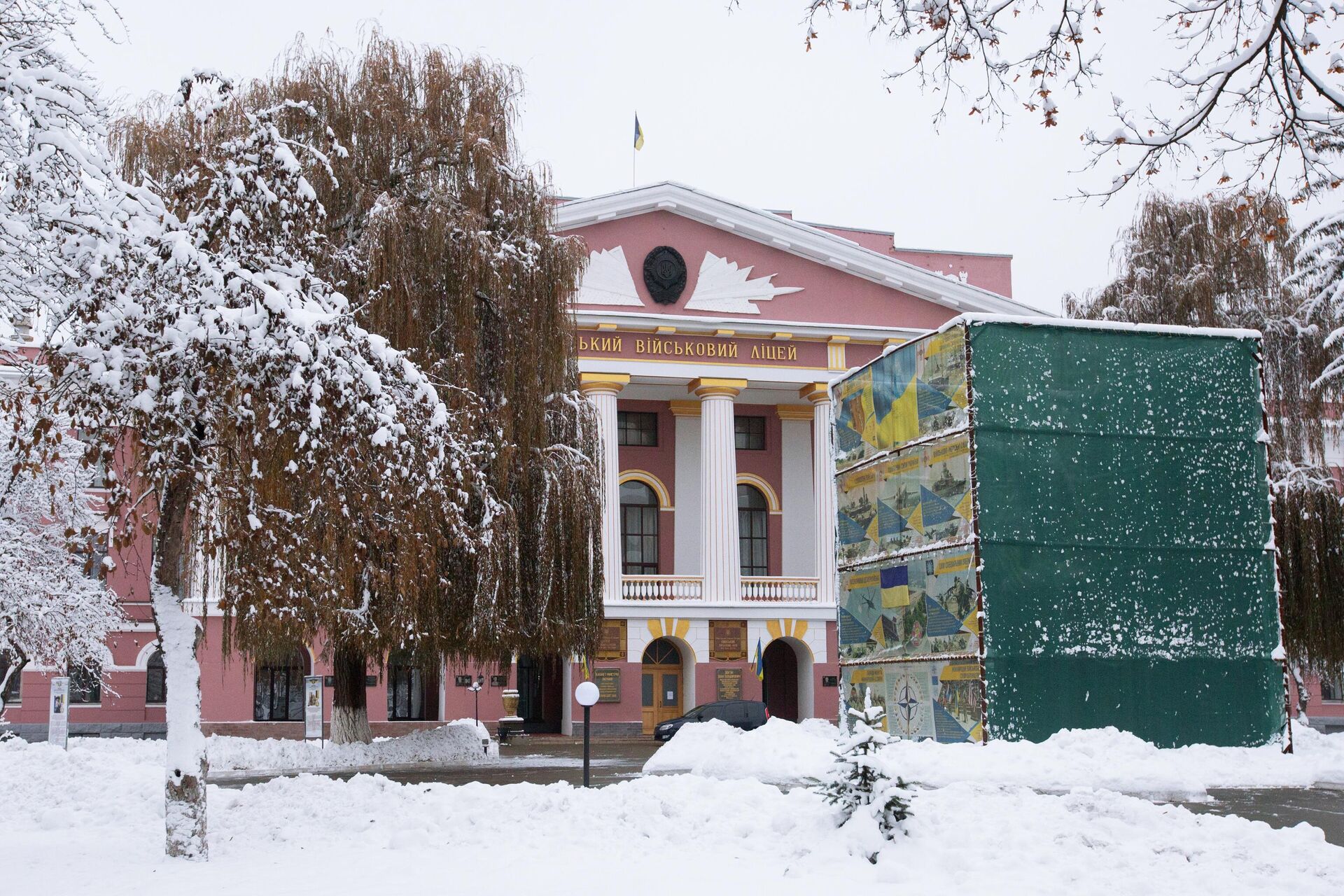
Fenced off monument to Russian commander Alexander Suvorov in the courtyard of the Ivan Bogun Military High School.
© Sputnik / Stringer
Tragedy of the Monument to Soviet Union’s Military Glory in Lvov
Radical activists raised the issue of at least partially dismantling the Monument of Glory, a monument to Soviet soldiers in Lvov, back in 2007. They demanded the dismantling of “imperial-Bolshevik symbols”.
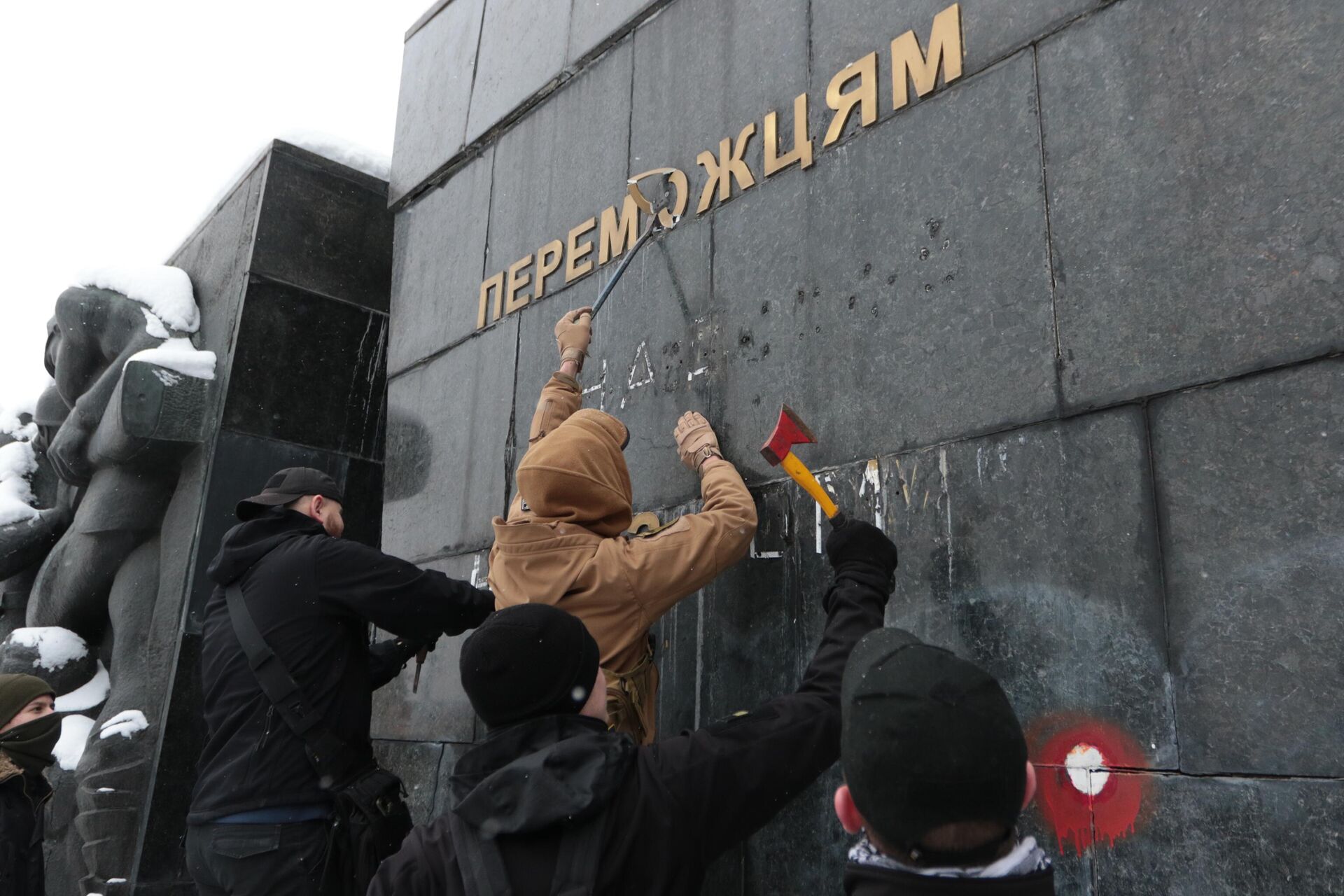
Nationalists break down inscriptions on the Monument of Glory in Lvov.
© Sputnik / Stringer
/ In April 2016, deputies of the Lvov City Council from the faction of the Ukrainian Galician Party appealed to the mayor with a petition requesting that the memorial complex be dismantled as it was not in conformity with the decommunization law. The adoption of an official decision was delayed. On 16 February 2018, nationalists from Right Sector*, the OUN Volunteer Battalion*, and Sokol destroyed the plates on the monument with sledgehammers.
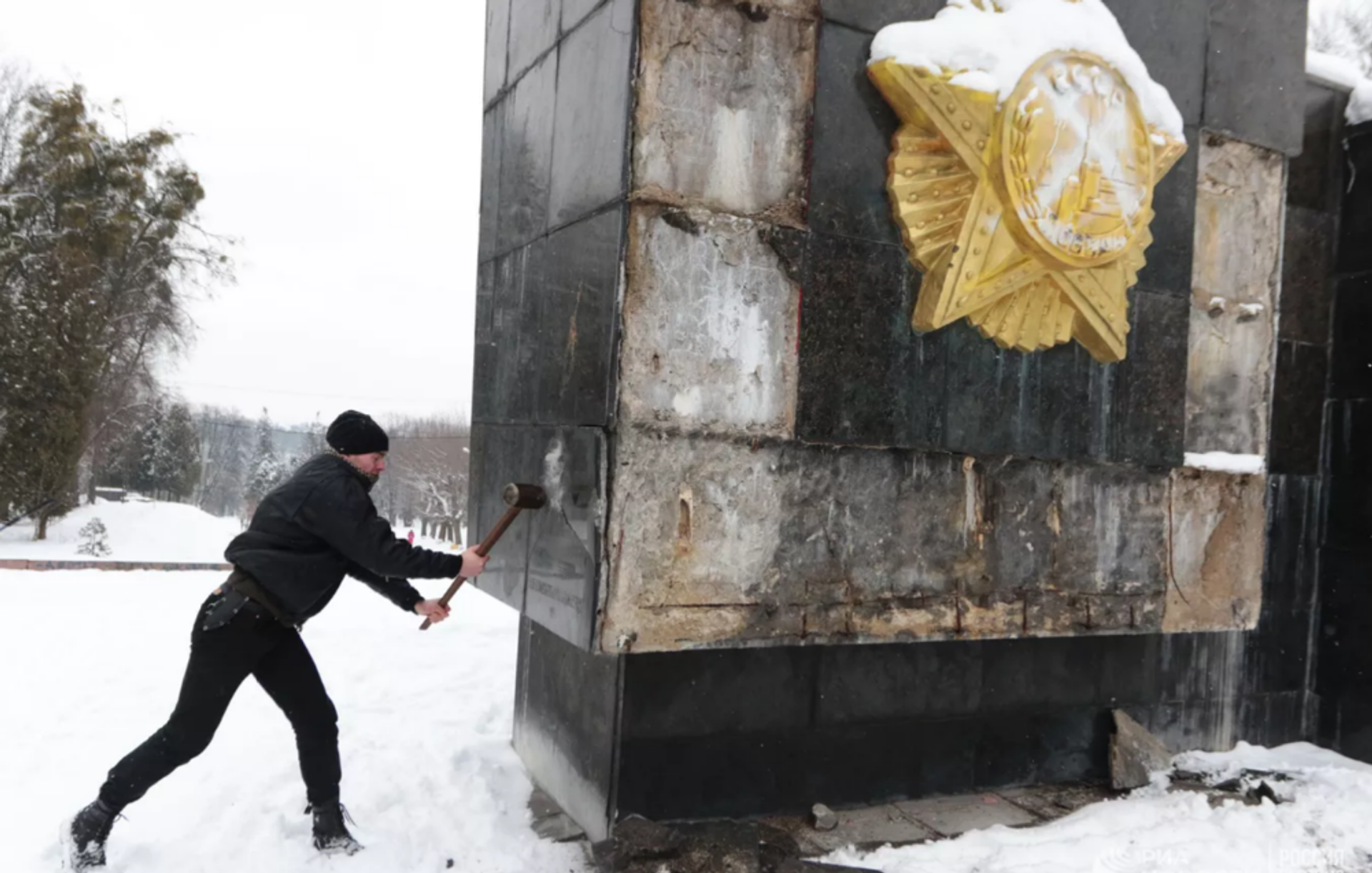
Nationalists destroy the Monument to the War Glory of the Soviet Army in Lvov.
© Sputnik / Stringer
The vandals also knocked down the iron inscription which read “To the Victors over Nazism” and in its place wrote “Monument to the Occupiers” in white paint.
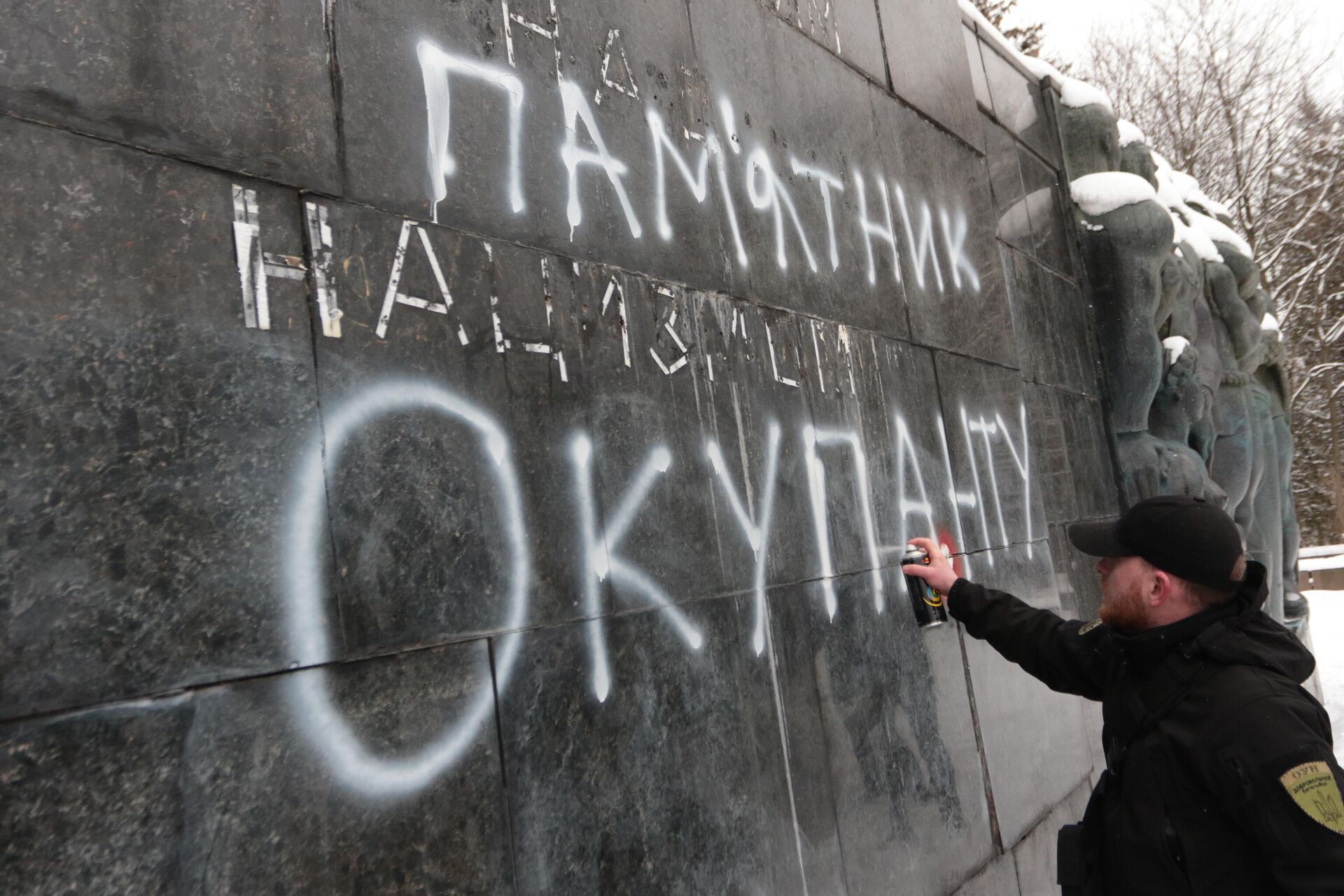
A nationalist inscribes “Monument to the Occupiers” on Lvov’s Monument of Glory.
© Sputnik / Stringer
/ The Monument to the War Glory of the Soviet Army was erected in Lvov’s Central Park of Culture and Recreation in 1970. It represented an ensemble of a 30-meter stele, a massive wall with figures of Red Army soldiers and two central sculptures symbolizing the soldier and the Motherland.
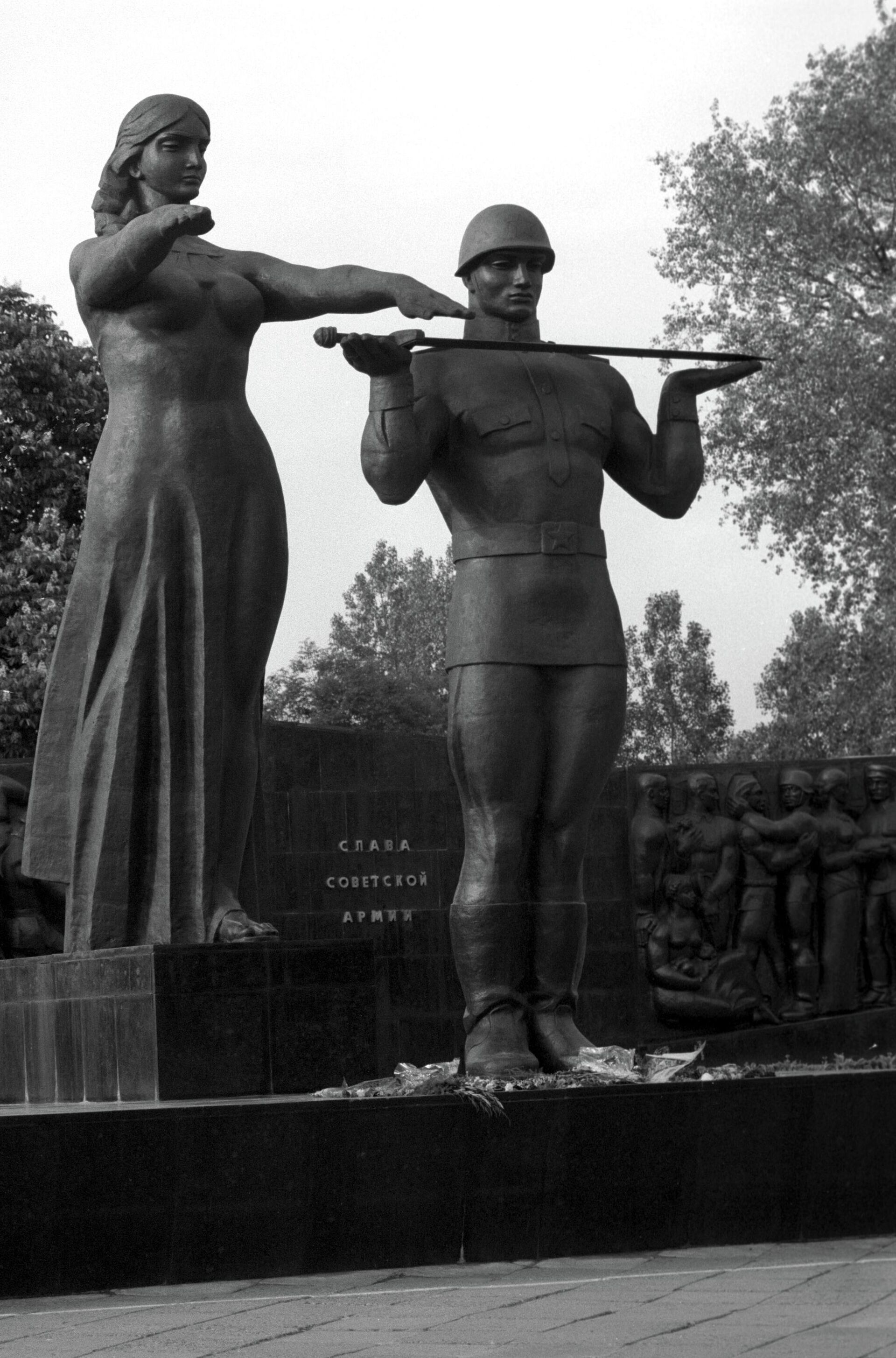
Monument to Soldier-Liberators, dedicated to the Soviet soldiers who died liberating the city from Nazi invaders in the Great Patriotic War (1941-1945).
© Sputnik / Sergei Subbotin
Technically, the monument did not fall under the law on so-called decommunization but no one in the Lvov administration was interested in this, and local officials decided to destroy the “occupation monument”.
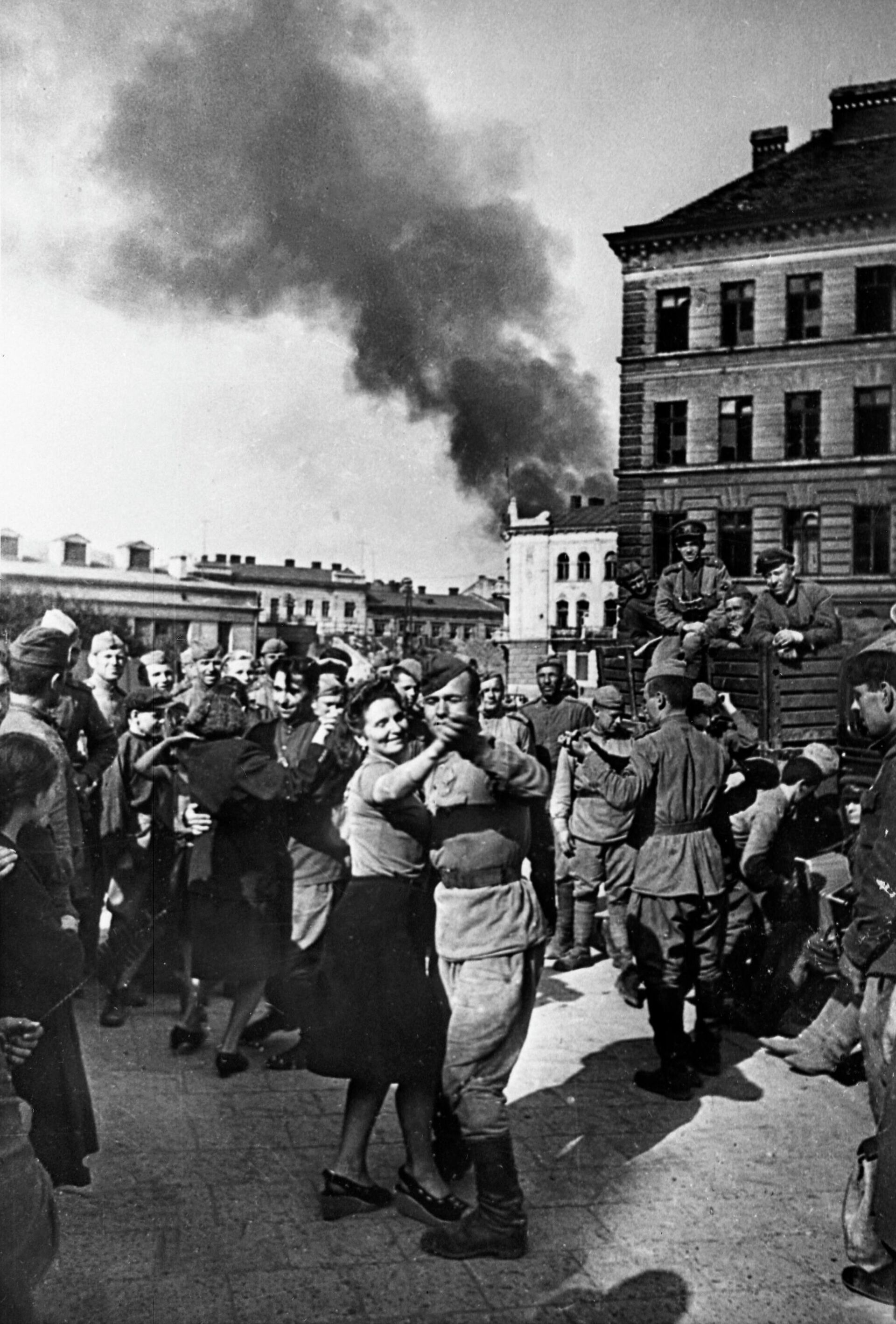
The streets of Lvov in the first days after the liberation of the city from German troops, July 1944.
© Sputnik / Arkady Shaikhet
Lvov was liberated from the Nazis in July 1944. Archival photographs testify that the city welcomed the Red Army soldiers as heroes. 75 years later, the descendants of those who once gave flowers to the Soviet soldiers decided to demolish the Monument of Glory.
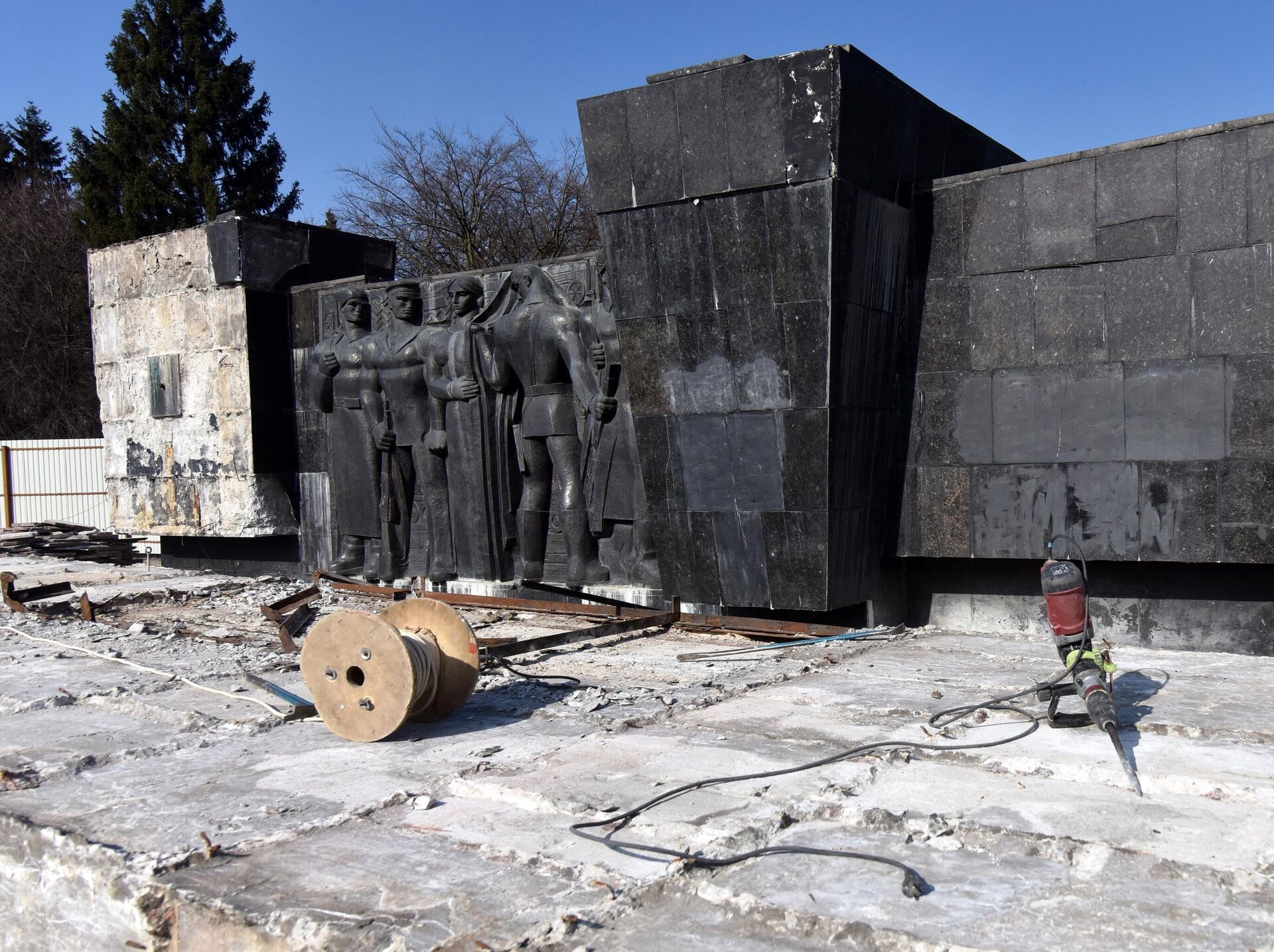
The stele of the Monument of Glory was dismantled in Lvov.
© Sputnik / Stringer
/ They started with the 30-meter stele. The Lvov authorities stated that it was in an emergency condition. They managed to demolish the “emergency” structure only on the third attempt. On 2 February 2019, five high reliefs installed in honor of Soviet soldiers were removed from the stele and transferred to the “Territory of Terror” museum. On 3 March, the stele itself was destroyed.
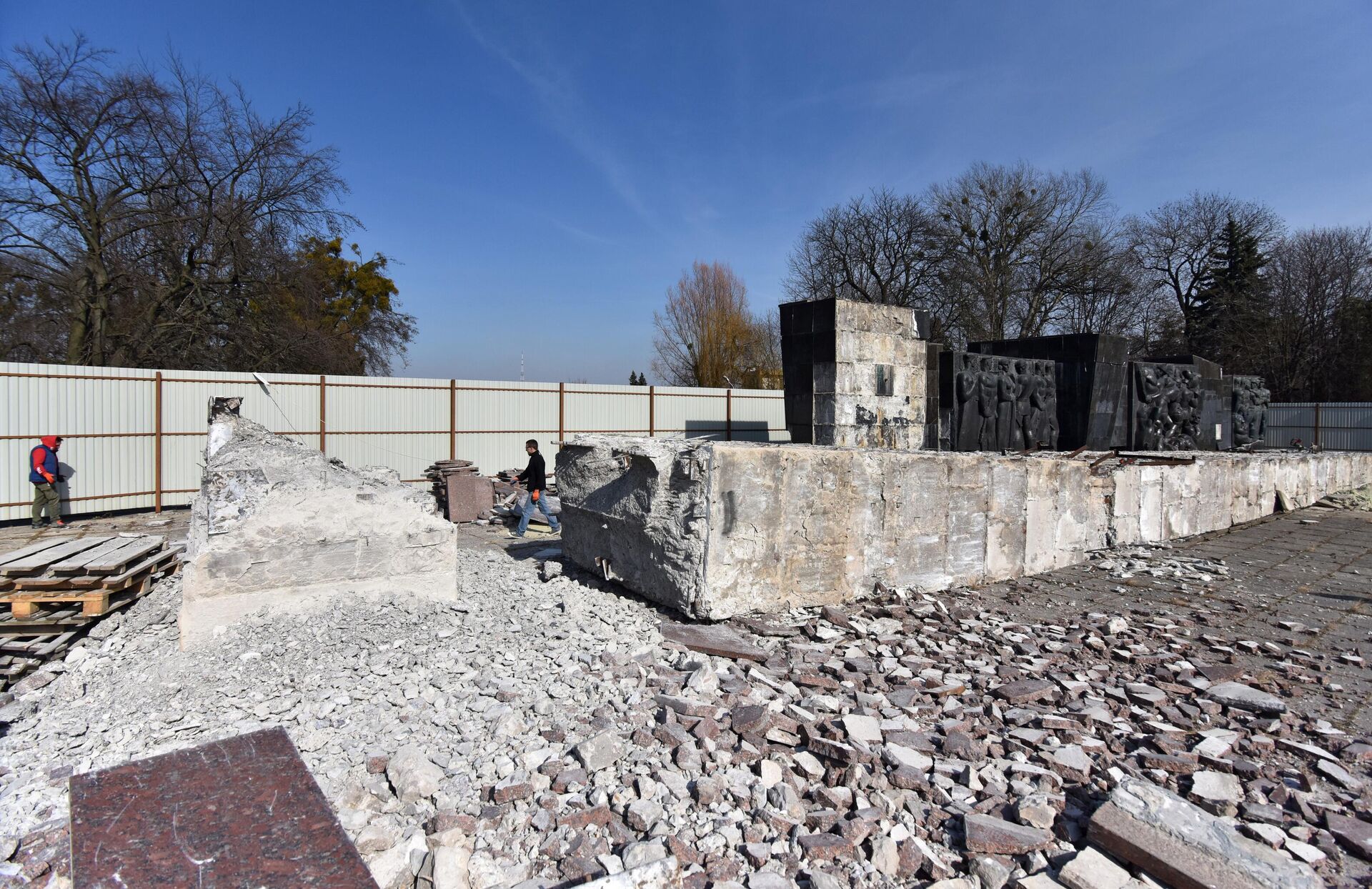
The stele of the Monument of Glory was dismantled in Lvov.
© Sputnik / Stringer
/ The city "celebrated" the 77th anniversary of Lvov’s liberation from the Nazis by completely destroying the monument to fallen soldiers in the Great Patriotic War. The last two figures of the memorial, the Soviet soldier and the Motherland, have disappeared from the Hill of Glory.
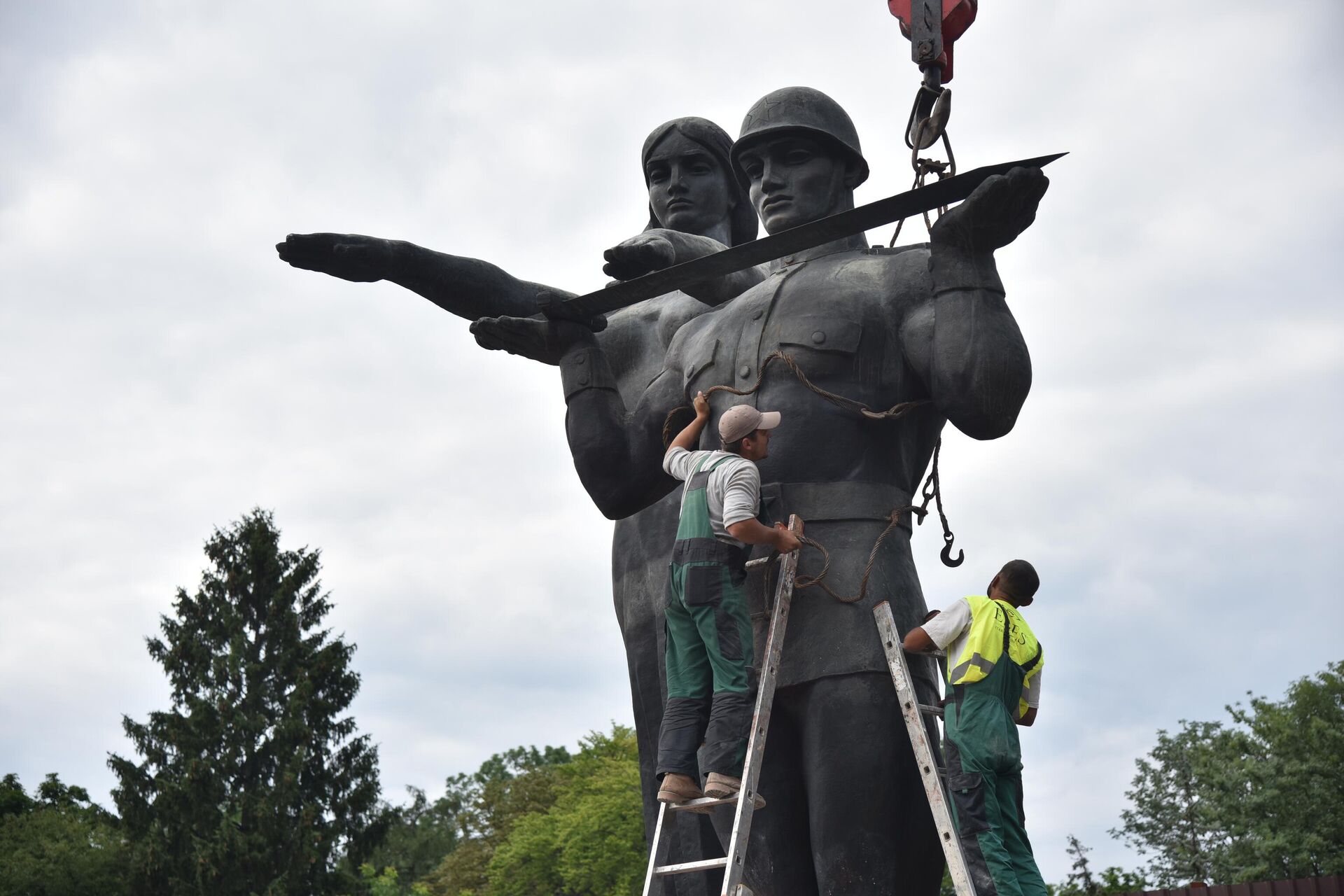
Dismantling of the last figures of the Monument to the Glory of the Soviet Army, opened in Lvov in 1970
© Sputnik / Stringer
Prince Vladimir's Cross
Kiev has outlawed not only political but also religious architectural symbols. On 25 May 2014, the monument to Vladimir the Great, the Baptizer of the Kievan Rus’, was desecrated on the embankment near Poshtova Square in Kiev. The cross, which was in the hands of the Holy Equal of the Apostles and Great Prince Vladimir, was smashed to pieces. The canonical community of the Ukrainian Orthodox Church perceived this act of vandalism as a direct threat and a harbinger of a religious war with it. The perpetrators were never found.

Destroyed monument to Great Prince Vladimir erected in Kiev, on the supposed site of the Christianization of Kievites (also known as the "Monument to the Baptism of Russia" and the "Column of Magdeburg Law").
© Sputnik / Konstantin Fedoseyev
Another sculpture of the Baptizer of the Kievan Rus’ also got in trouble. The monument to Vladimir the Great is the oldest sculptural monument in Kiev. It was built in 1853 and is considered one of the unofficial symbols of the city. In March 2017, unidentified perpetrators spilled red paint on the figure of Prince Vladimir.
‘Monument to Hungarian Chauvinism’
It was not only monuments related to Russia that were unwanted: any monument that did not correspond to the "correct" history of Ukraine could be targeted. On the night of 11 March 2014, in the Transcarpathian region, extremists threw paint on a memorial to the Hungarian tribes’ crossing through the Carpathians to the Danube valley, which was erected on the Veretski Pass.
Vandals wrote on the northern side of the architectural complex: “Budapest, repent for Carpathian Ukraine!” and on the western side – "Glory to Ukraine!” Furthermore, the monument was sprayed with blue-and-yellow swastikas and the Ukrainian coat of arms.
The Hungarian community still managed to defend the memorial, which was erected on the territory where they historically lived. Nevertheless, a year earlier, a local deputy of the right-wing Svoboda radical party Ostap Stahiv called for help in destroying the "monument to Hungarian chauvinism" in Transcarpathia.
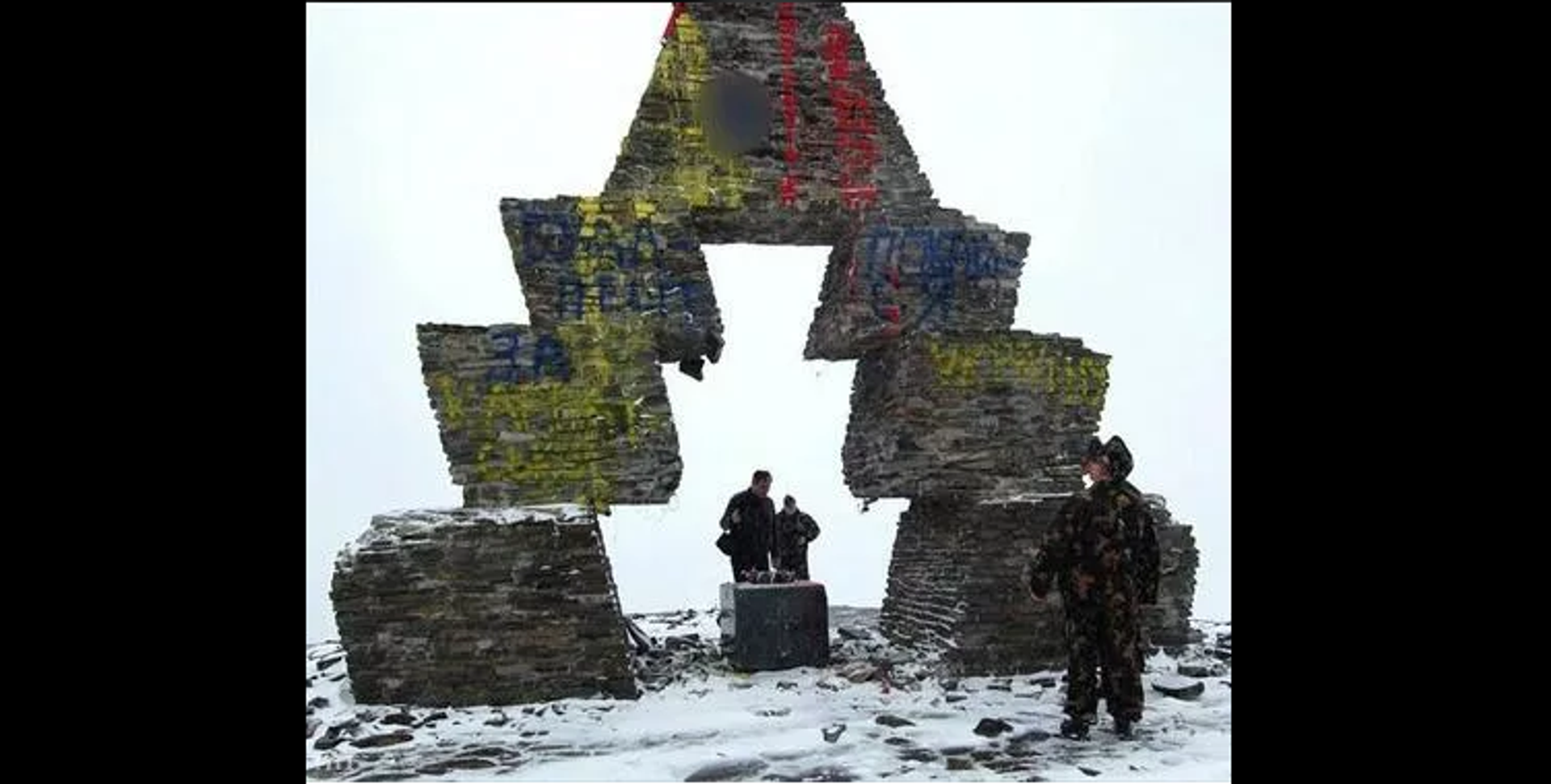
Desecrated monument at the Veretski Pass in honor of the 1100th anniversary of the Hungarians' crossing of the Carpathian Mountains.
© Sputnik
'Unwanted' Huta Pieniacka
In January 2017, Ukrainian neoNazis desecrated a memorial to the victims of the SS-Volunteer Division “Galicia” in the village of Huta Pieniacka in Lvov. This once large village was burned to the ground during the 1944 Volyn Massacre (the massacres of Poles in Volhynia and Eastern Galicia), when Ukrainian nationalists massacred the Polish population of Galicia. Vandals destroyed the memorial cross, painted the columns the colors of the Ukrainian and neoNazi flags, and drew two lightning bolts, a runic symbol of the SS. The perpetrators were never found.

1/3
© Photo
A desecrated monument to the perished villagers of Huta Pieniacka, who were killed by members of the SS-Volunteer Division “Galicia” and the UPA (an extremist organization outlawed in Russia). Huta Pieniacka was a Polish village located on the territory of modern-day Lvov in Ukraine.
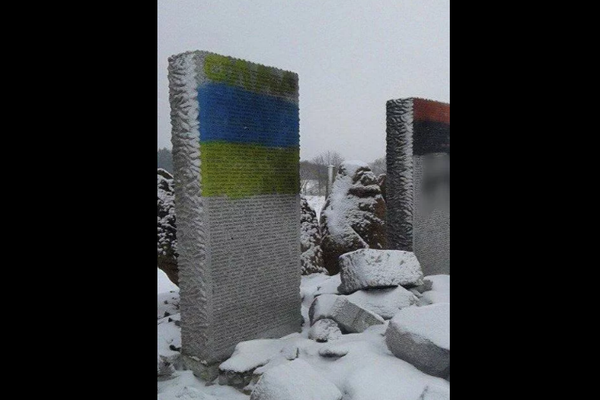
2/3
© Photo
A desecrated monument to the perished villagers of Huta Pieniacka, who were killed by members of the SS-Volunteer Division “Galicia” and the UPA (an extremist organization outlawed in Russia). Huta Pieniacka was a Polish village located on the territory of modern-day Lvov in Ukraine.
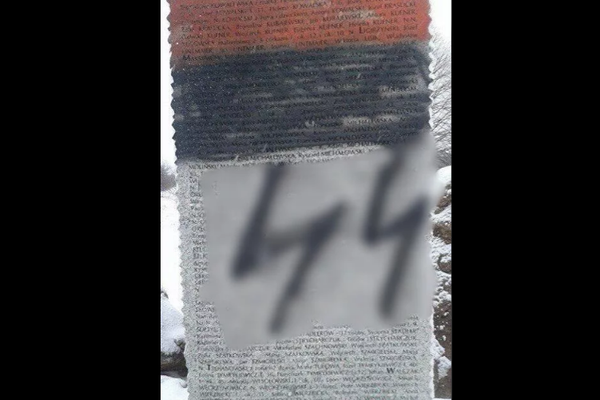
3/3
© Photo
A desecrated monument to the perished villagers of Huta Pieniacka, who were killed by members of the SS-Volunteer Division “Galicia” and the UPA (an extremist organization outlawed in Russia). Huta Pieniacka was a Polish village located on the territory of modern-day Lvov in Ukraine.
1/3
© Photo
A desecrated monument to the perished villagers of Huta Pieniacka, who were killed by members of the SS-Volunteer Division “Galicia” and the UPA (an extremist organization outlawed in Russia). Huta Pieniacka was a Polish village located on the territory of modern-day Lvov in Ukraine.
2/3
© Photo
A desecrated monument to the perished villagers of Huta Pieniacka, who were killed by members of the SS-Volunteer Division “Galicia” and the UPA (an extremist organization outlawed in Russia). Huta Pieniacka was a Polish village located on the territory of modern-day Lvov in Ukraine.
3/3
© Photo
A desecrated monument to the perished villagers of Huta Pieniacka, who were killed by members of the SS-Volunteer Division “Galicia” and the UPA (an extremist organization outlawed in Russia). Huta Pieniacka was a Polish village located on the territory of modern-day Lvov in Ukraine.
NeoNazis desecrated memorials not only in their own country but also beyond its borders. In November 2021, radicals from Ukraine damaged the monument to Marshal Pilsudski and the Polish Legions’ War Memorial. Jozef Pilsudski was a statesman and political leader, a founder of the Polish Army and the first head of the Polish Republic. The vandals left their favorite “Wolfsangel” on the pedestal of the statue of Pilsudski, and painted the legionnaires' figures in yellow-and-blue.
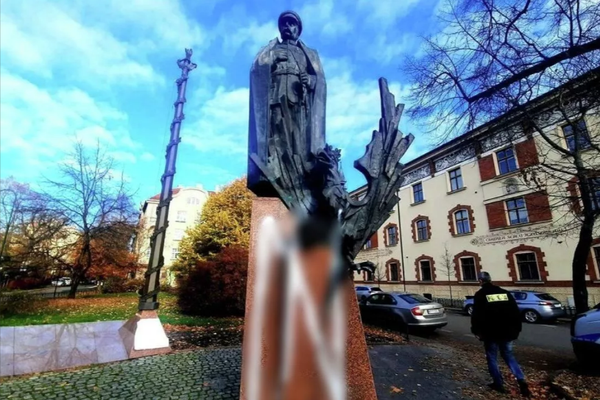
1/2
© Photo
The monument to Polish statesman Jozef Pilsudski desecrated by Ukrainian vandals, Krakow, Poland.
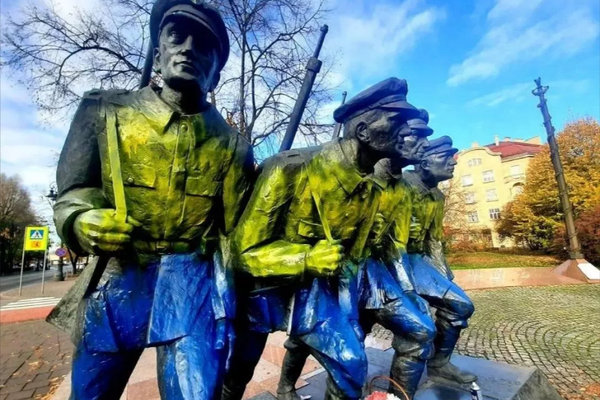
2/2
© Photo
The Polish Legions’ War Memorial spray-painted by Ukrainian vandals, Krakow, Poland.
1/2
© Photo
The monument to Polish statesman Jozef Pilsudski desecrated by Ukrainian vandals, Krakow, Poland.
2/2
© Photo
The Polish Legions’ War Memorial spray-painted by Ukrainian vandals, Krakow, Poland.
As a farewell, the intruders left a misspelled note in Ukrainian: “Pol’sa ne tilki dlya paniv” (“Poland is not only for the gentlemen” – ed. note Sputnik). In Ukrainian, Poland is spelled with a “sh” – “Pol’sha”.
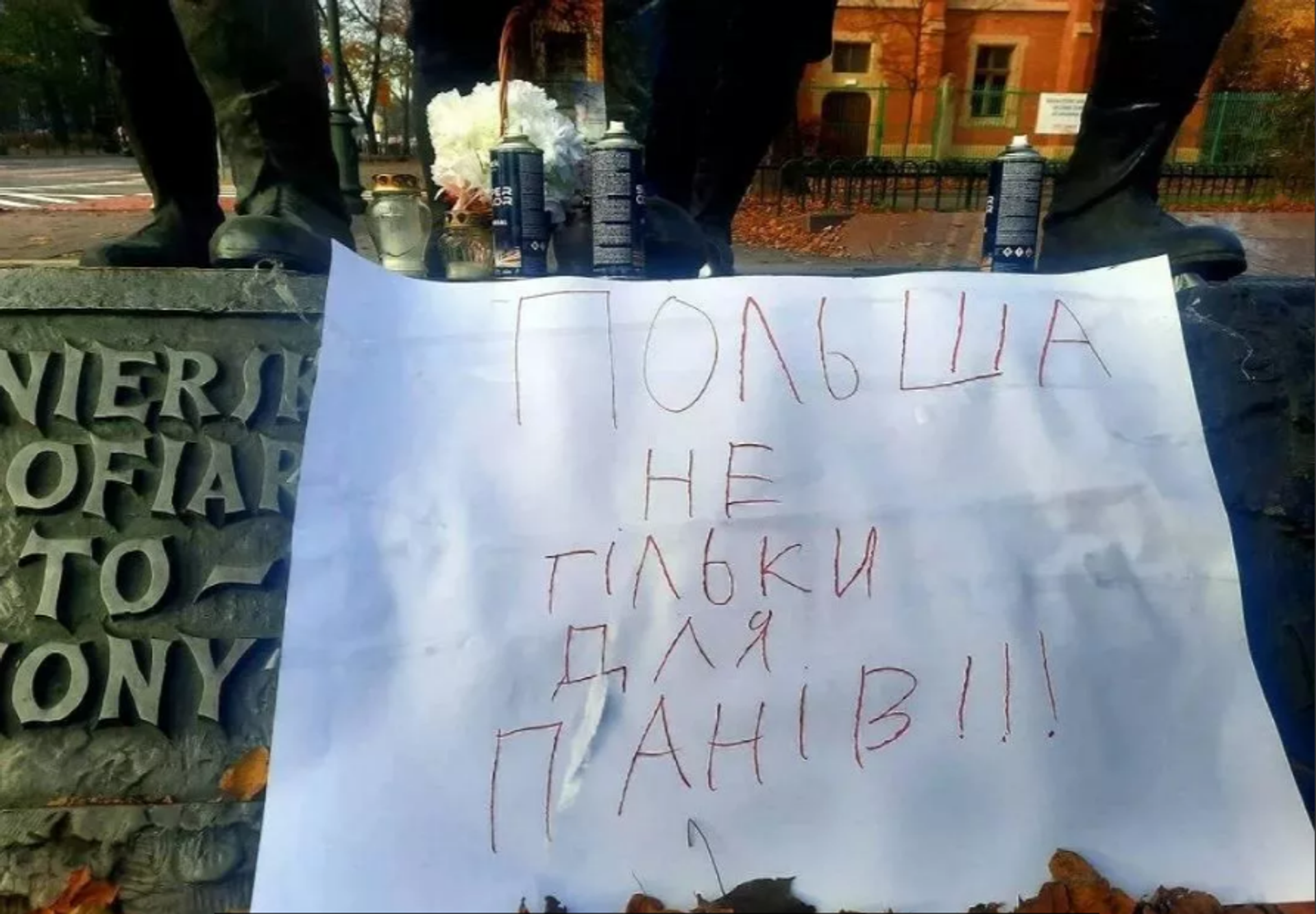
A note left by Ukrainian vandals at the monument to Polish statesman Jozef Pilsudski and the Polish Legionnaires in Krakow.
© Photo
The Holocaust and Anti-Semitic Campaigns
Architectural symbols linked to the history of Ukrainian Jews and the Holocaust have been targets of radical attacks no less frequently than memorials to Soviet heritage.
On the night of 9 April 2014, unidentified perpetrators painted a swastika and a neoNazi “Wolfsangel” on a monument to Holocaust victims in Odessa. The same night, dozens of gravestones on Jewish graves in the local cemetery were desecrated. The perpetrators were never found.
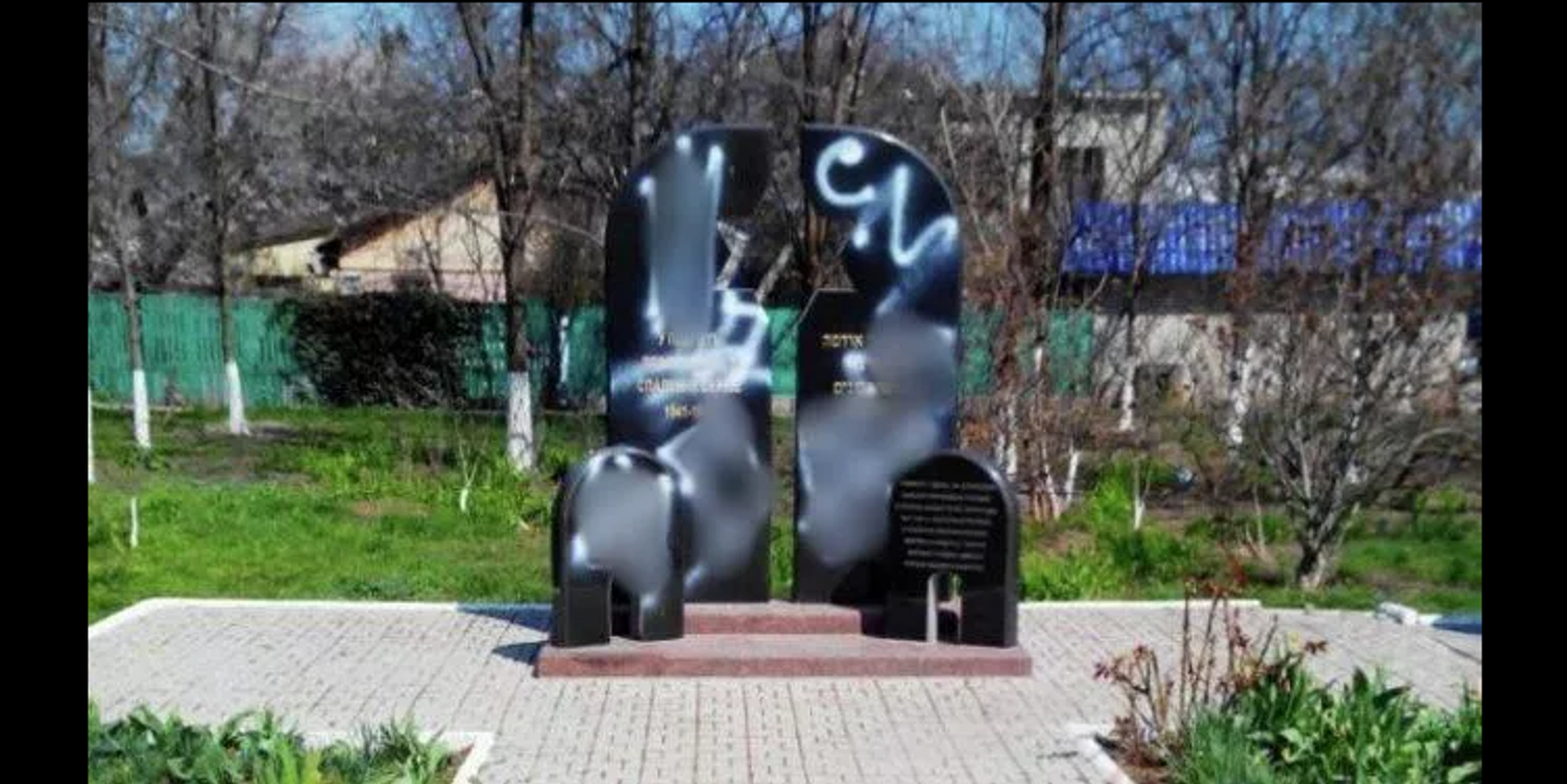
A desecrated memorial to Holocaust victims in Odessa.
© Sputnik
In January 2022, vandals destroyed a monument to Holocaust victims in Lysychansk (a city in Lugansk region, at the time located in Kiev-controlled territory. – ed. note Sputnik). Moreover, this was the second attack on the memorial “To the Jewish victims killed during the Nazi occupation of Lysychansk in 1942-1943". The city administration published the following message on its official Facebook page (the activity of Meta, Facebook and Instagram social networks, is outlawed in Russia as extremist):
At the start of December last year, this very memorial sign had already been destroyed. At the expense of indifferent citizens of the city a new memorial sign was made and installed. It is noteworthy that this happened on the eve of Holocaust Memorial Day, celebrated by the entire international community on January 27.
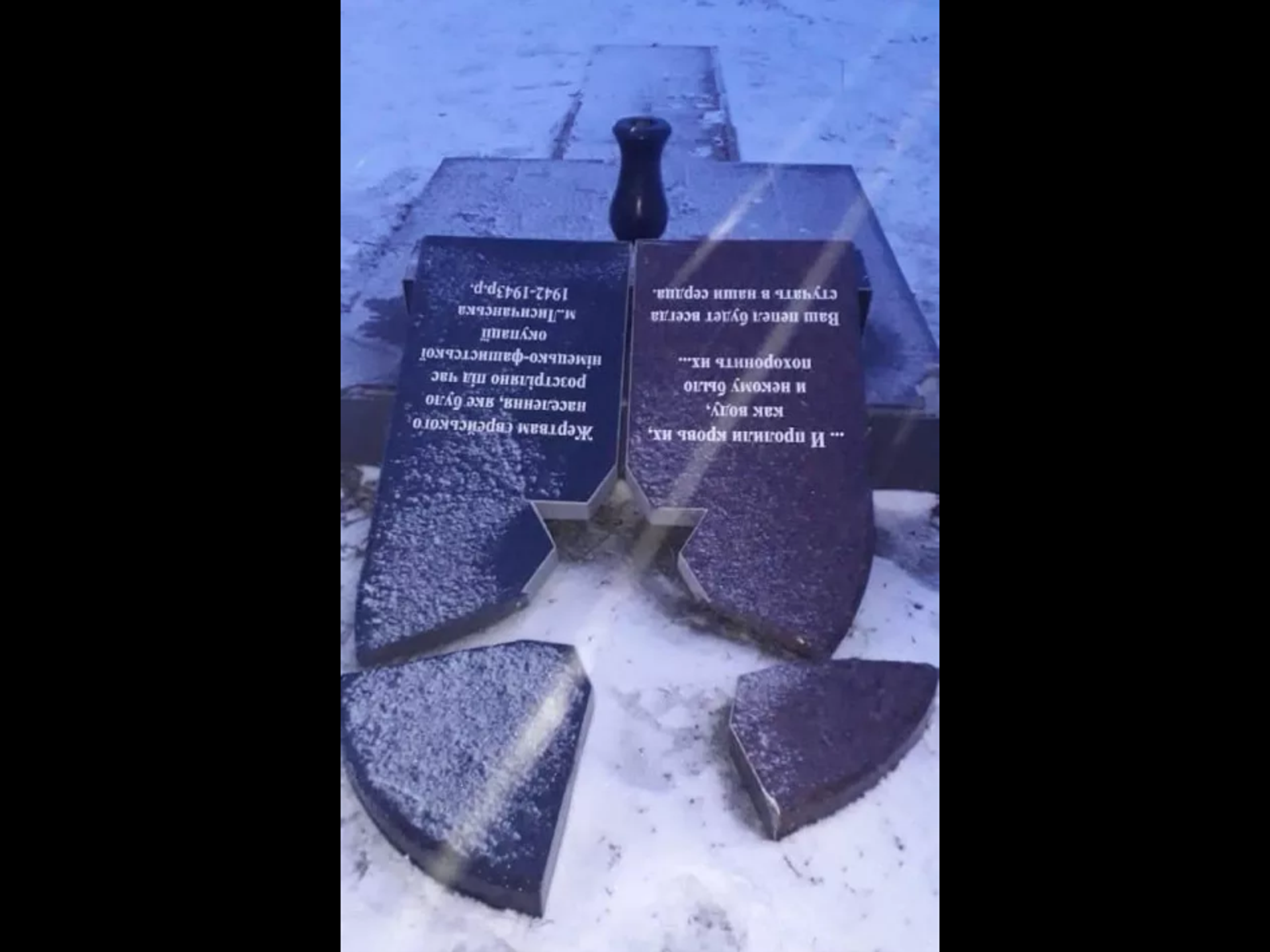
A smashed monument to Holocaust victims in Lysychansk.
© Sputnik
A similar crime was committed in the city of Dnepr. On 28 January 2022, unidentified perpetrators broke lamps at the monument to Holocaust victims installed in Gagarin Park, and the memorial itself was doused with paint. Igor Romanov, executive director of the Union of Jewish Religious Communities and Organizations of the Dniepropetrovsk Region, noted that there were no cameras in the park and that previous desecrations of the memorials had gone unpunished:

A desecrated memorial to Holocaust victims in Gagarin Park (Dniepropetrovsk).
© Sputnik
This is not the first time this has happened. As a rule, it is either timed to coincide with Jewish holidays or, like yesterday, when there was a mourning date, the International Holocaust Remembrance Day. I think this was instigated to coincide with that date.
In 2019, unidentified perpetrators drew a swastika on a monument to Yiddish Jewish author Sholem Aleichem in Kiev.

Vandalized monument to Sholem Aleichem in Kiev.
© Photo
We did not even list all the cases of desecration and destruction of monuments. One may get the impression that Ukrainian neoNazis are trying to destroy everything that does not fit into their “new history” and national idea. However, the new ideology cannot be imposed on everyone, and to every action, there is always an equal reaction.
In June 2019, unidentified perpetrators splattered paint on a monument to the UPA* in the Youth Park in Kharkov. The criminal liability for "hooliganism" of the Criminal Code of Ukraine provides for a penalty of up to five years in prison, but even this does not stop those who are against the glorification of the Nazis in their hometown.
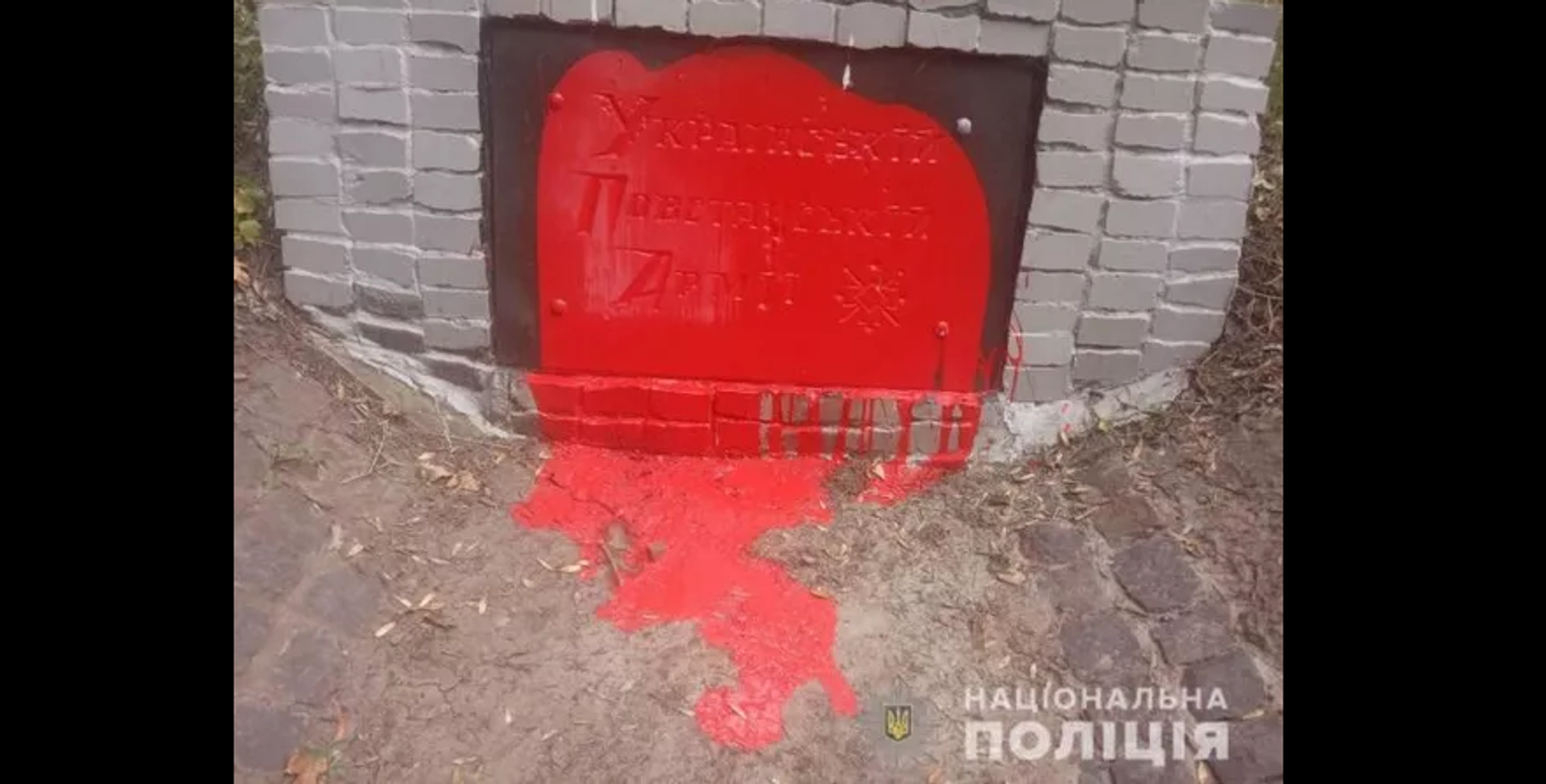
Unidentified perpetrators splattered paint on a monument to the UPA* in the Youth Park in Kharkov. (*an extremist organization banned in Russia).
© Photo
The monument to the dead UPA members* was erected in October 1992, and since, activists have tried to demolish it more than 100 times. The city authorities have repeatedly repaired the damage, ignoring the obvious reluctance of Kharkov citizens to honor Nazi accomplices in the park.
The national hero of independent Ukraine – Stepan Bandera – was not spared the love as well. A monument to the leader of the OUN* and one of the founders of the UPA was unveiled in October 2007 in Lvov. In August 2019, unidentified perpetrators drew a hammer and sickle on its pedestal.

Defaced monument to Stepan Bandera in Lvov.
© Photo
In February 2021, the monument was doused with paint, one of the students caught on charges of vandalism was sentenced to four years in prison with probation for two years, but he was later paroled.
A similar monument to the collaborator, erected in Ternopol in 2008, was also doused with paint in mid-December 2021.

Defaced monument to Stepan Bandera in Ternopol.
© Photo
A week later, an unidentified person threw eggs at the monument. This was the last straw for the radical nationalists, who called for the monument to be protected.
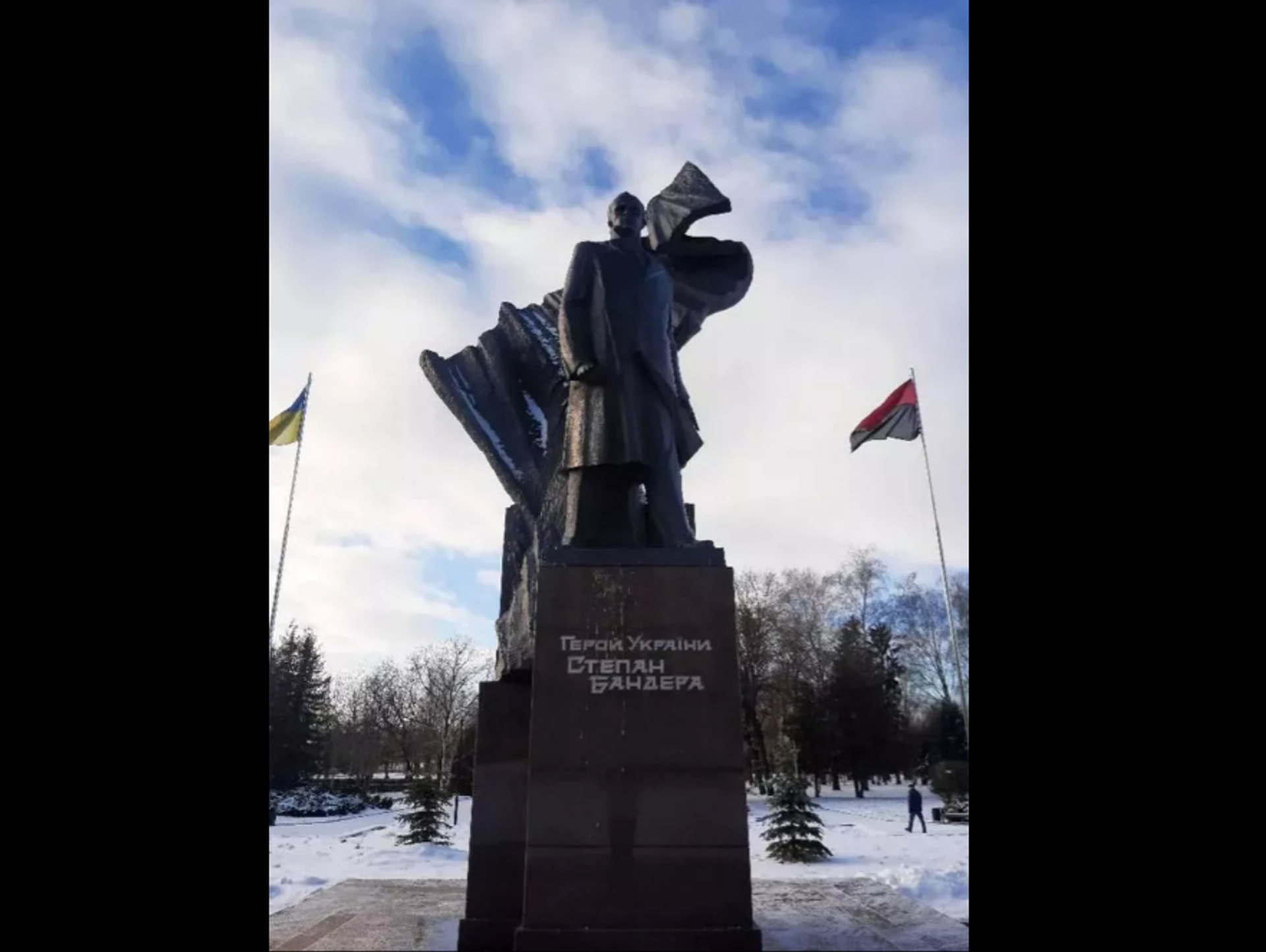
An unidentified person threw eggs at the monument to Bandera in Ternopol.
© Photo
A few days after the egg attack, Bogdan Butkovsky, a deputy of the Ternopil Regional Council, said:
A joint squad, in particular, of police officers and soldiers of the Ternopil Battalion will guard the pedestal. Stepan Andreevich is under heavy round-the-clock guard! Nobody can spoil our holidays! (Stepan Bandera's birthday is celebrated in Ukraine on January 1 every year since 2019. – ed. note Sputnik).
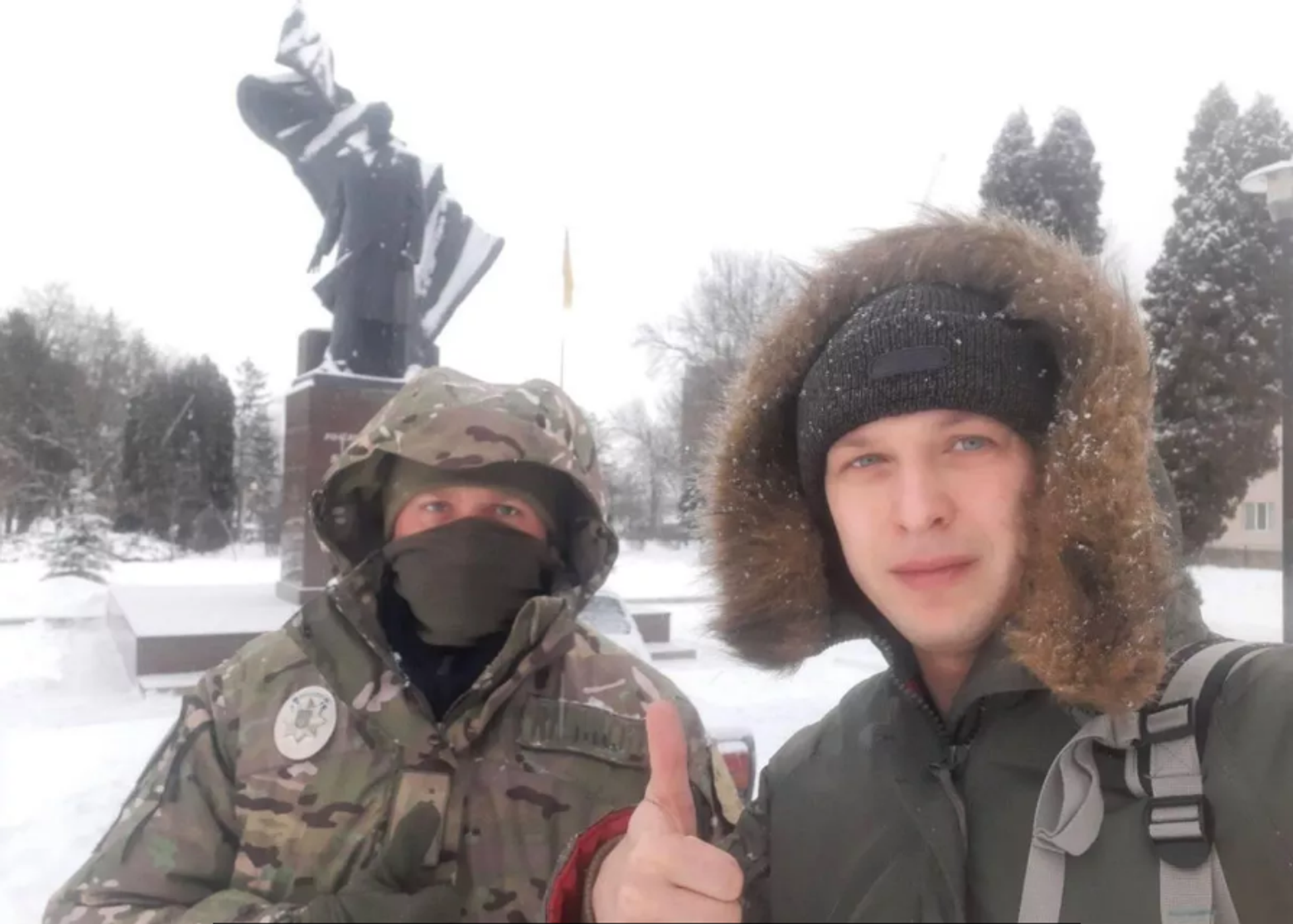
For the protection of the monument to Stepan Bandera, police officers and members of the Ternopil Battalion were brought in.
© Photo
In comments to the publication, users ridiculed the authorities' decision: “Afraid he'll run away?”, “Protecting a monument to a 'hero' from people's love?”, “Afraid he'll go for strawberries [to Poland], too?” More often than not, commentators asked why authorities had to erect a monument that then had to be guarded at all, and why not just remove it if it causes so much irritation with the residents?
It seems that the Kiev regime simply refuses to accept the fact that some citizens will never accept the Nazification of their country. Despite all the efforts of the Euromaidan supporters who came to power, there are still those in Ukraine who do not consider their nation superior to others. Those who have not forgotten the great feat of the multinational Soviet people, who gave a joint response to fascism. Those for whom Bandera, Shukhevich and other renegade collaborators will never become heroes. And there are many such people in Ukraine.
*extremist organizations banned in Russia.



